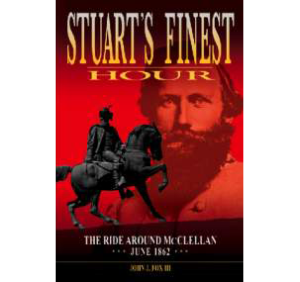 Stuart’s Finest Hour: The Ride Around McClellan, June 1862 is ready as an E-Book at KINDLE and NOOK. Stuart’s Finest Hour is also available on I-TUNES. The Confederate Alamo: Bloodbath at Petersburg’s Ft. Gregg is available in KINDLE and NOOK. Many thanks to Savas Beatie Historical Publishers for their help making these award-winning books possible!
Stuart’s Finest Hour: The Ride Around McClellan, June 1862 is ready as an E-Book at KINDLE and NOOK. Stuart’s Finest Hour is also available on I-TUNES. The Confederate Alamo: Bloodbath at Petersburg’s Ft. Gregg is available in KINDLE and NOOK. Many thanks to Savas Beatie Historical Publishers for their help making these award-winning books possible! 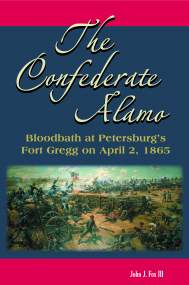
Two Angle Valley Press Titles Available as E-Books
Angle Valley Press 10th Anniversary & Father’s Day Sale – Huge Civil War Book Discounts!
Celebrate the 10th anniversary of Angle Valley Press together with the upcoming Father’s Day. We are steeply discounting almost all of our Civil War books until midnight on Sunday June 22. We want to thank all of our customers for your support since 2004! CLICK ABOVE ON “OUR BOOKS” ICON to see the SPECIALS.
Stuart’s Finest Hour Receives IPPY Book Award
Winchester Author Receives Award for Civil War Book
By Nancy Jones, Angle Valley Press, LLC
FOR IMMEDIATE RELEASE
John J. Fox’s Stuart’s Finest Hour: The Ride Around McClellan, June 1862 awarded a 2014 IPPY Bronze Medal for Mid-Atlantic’s Best Regional Non-Fiction category.
“Utilizing previously unseen primary sources, he has created a deeply researched and smooth-reading narrative that has the sounds of bugles, saber strikes, and thundering hoofs resonating from its pages.” ~ Paul Taylor, Civil War News, January 2014
Winchester, VA., May 27, 2014 – The Independent Publisher Book Awards are conducted annually and honor this year’s best independently published titles from all over the world. The 2014 IPPYS will highlight the best regional titles from North America and Australia/New Zealand.The official 2014 IPPY medal ceremony will take place on May 28 in New York City, one day before the opening of the BookExpo America Conference.
John Fox’s award-winning title is the first book ever written about the dramatic Great Chickahominy Raid that  made Confederate cavalry General Jeb Stuart famous. Stuart led 1,200 horsemen on a dangerous three-day reconnaissance mission deep behind Union lines east of Richmond, Virginia in mid-June 1862. The information that Stuart carried back to Richmond gave General Robert E. Lee the confidence to attack the right flank of General George McClellan’s Federal army. The tactical and strategic impact of Stuart’s raid allowed the subsequent Confederate offensive, known as the Seven Days’ Battles, to push the numerically superior Union army away from Richmond. The war lasted almost three more bloody years before Federal troops would have another similar opportunity to capture Richmond.
made Confederate cavalry General Jeb Stuart famous. Stuart led 1,200 horsemen on a dangerous three-day reconnaissance mission deep behind Union lines east of Richmond, Virginia in mid-June 1862. The information that Stuart carried back to Richmond gave General Robert E. Lee the confidence to attack the right flank of General George McClellan’s Federal army. The tactical and strategic impact of Stuart’s raid allowed the subsequent Confederate offensive, known as the Seven Days’ Battles, to push the numerically superior Union army away from Richmond. The war lasted almost three more bloody years before Federal troops would have another similar opportunity to capture Richmond.
Savas Beatie LLC is a leading independent military and general history publishing companythat markets Angle Valley Press titles to museum and park bookstores throughout the country. Their managing director, Theodore P. Savas, noted, “We are pleased this award went to John Fox and Angle Valley Press. He is one of the finest researchers and writers working today in Civil War history, and this award proves it. Stuart’s Finest Hour is an example of his dedication to first class history.”

Angle Valley Press LLC is a Winchester-based history book publisher in business since 2004.
John J. Fox is an award-winning Civil War historian who lives in Winchester, Virginia. He is the author or editor of several books and articles about the Civil War including Red Clay to Richmond [2004] and The Confederate Alamo [2010].
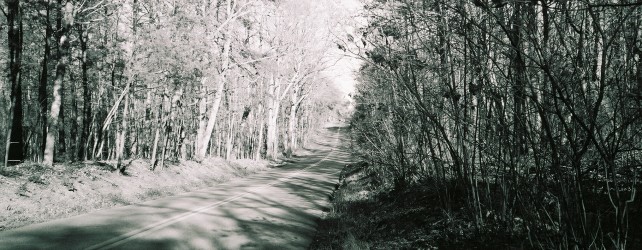
Confederate Roar at Wilderness on Night of May 7, 1864
A battlefield roar that invigorated the Confederates echoed along their line in the middle of the Wilderness on the evening of May 7. Most of George Meade’s Army of the Potomac and Robert E. Lee’s Army of Northern Virginia faced each other behind defense lines deep in the tangled gnarl of the Wilderness woods. Two previous days of grisly fighting had decimated the ranks of both sides and now each commander tried to assess the others intentions.
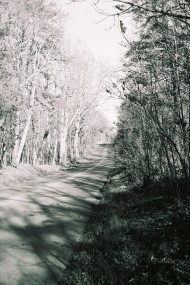
Battle of Wilderness – Orange Plank Road looking east toward Federal Position near Brock Road intersection. Notice density of brush and this photo taken in winter w/out foliage. This image is actual site where Edward Thomas’ Georgia Brigade manned the line early on May 6, 1864
The defense lines stretched from Orange Turnpike south beyond Orange Plank Road as “the brush fires continued to try to cleanse the battleground of its grisly sites. The acrid smell of wood smoke filled the air. This smoke frequently blotted out sunlight. That night, a spontaneous unforgettable vocal display occurred in the woods of the Wilderness. Far to the south at the right end of Lee’s line a distant noise broke the night air. All along the line men paused to determine its source. The sound soon grew louder. The noise was the shouts of Confederate soldiers. More men joined the roar as it rolled from regiment to regiment along the line from right to left. The sound echoed northward until it reached the far end of Ewell’s corps.”
“Again the shout arose on the right – again it rushed down upon us from a distance of perhaps two miles – again we caught it and flung it joyously to the left, where it only ceased when the last post had huzzahed. And yet a third time this mighty wave of sound rang along the Confederate lines. The effect was beyond expression. It seemed to fill every heart with new life, to inspire every nerve with might never known before. Men seemed fairly convulsed with the fierce enthusiasm; and I believe that if at that instant the advance of the whole army upon Grant could have been ordered, we would have swept it into the very Rappahannock.”
The armies next tangled at a place called Spotsylvania Court Houseagain – 150 years ago from right now.
Footnotes: 2nd paragraph from John J. Fox III, Red Clay to Richmond: Trail of the 35th Georgia. (Winchester, 2004. Angle Valley Press, p. 254-256.
3rd paragraph originally found in – J.F.J. Caldwell, The History of a Brigade of South Carolinians Known As ‘Gregg’s’, and Subsequently As ‘McGowan’s’ Brigade. (Philadelphia, 1866) (Morningside Press reprint 1992, Dayton, Oh. , p.184).

Who is the 35th Georgian on the cover of Red Clay to Richmond?
Ever since Red Clay to Richmond was released ten years ago, I have been asked many times about the 35th Georgia soldier on the cover. Well, that serious face with haunting eyes belonged to Private John Rigby from Company D, 35th Georgia. Before he enlisted in 1861, he was a sharecropper in Hogansville, Georgia. The bowie knife in the left hand and the bayonet-tipped rifle in the right seemed to foreshadow the tough battlefields he would soon cross as the image was probably taken in Richmond in early spring 1862 before he and his fellow Georgians had officially seen “the elephant” in a full-scale fight.
Rigby would be wounded on June 26, 1862 at the Battle of Mechanicsville at the beginning of the Seven Days’ Battles. Hit in the right thigh and left chest, he suffered a collapsed lung. Once his condition stabilized doctors sent him to convalesce at home in Troup County. While there his wife, Nancy, nursed him back to health and her heart must have broken again when he left in December to return to the fighting in Virginia. When they parted she would never see her husband again. 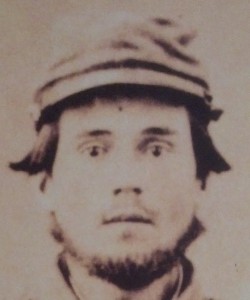
John somehow survived unscathed the heavy fighting of 1863 at Chancellorsville and Gettysburg. He no doubt longed for a furlough back to Georgia, but by the winter of 1863-1864 the manpower shortage in the Army of Northern Virginia had reached epic numbers especially with James Longstreet’s corps detached to reinforce Braxton Bragg’s army in Georgia and Tennessee.
March 1864 found Edward Thomas’ Georgia Brigade [14th, 45th, 49th and 35th Georgia regiments] back in winter camp near Orange Court House with the rest of Robert E. Lee’s army. The Georgians had spent the previous three months in the Shenandoah Valley marching and countermarching in bitter cold trying to drive various Federal units away.
Then on May 2, “as if to foreshadow the coming violence of battle a horrendous thunderstorm passed over the Orange Court House area” flattening tents and scattering equipment. Two days later, numerous 35th Georgians attended a prayer meeting, but a courier soon arrived “with orders for the men to strike tents and to cook two days’ rations.” The Georgians departed camp that night around 10 pm. The column passed through Orange CH and then “turned east onto the Orange Plank Road toward Fredericksburg.” The Overland Campaign had begun.
What these Confederates didn’t know was that the Army of the Potomac was on the move from their winter camps around Culpeper. It would be a race to see if the Rebels could move far enough east to block the long blue columns moving across the Rapidan River toward the important crossroads where Wilderness Tavern stood.
Both armies banged into each other on May 5. As the sun began to set, Thomas’ men moved into the murky woods north of the Orange Plank Road and about a half-mile north of the Widow Tapp Farm. The Georgians soon found themselves fighting from three sides due to an attack by four brigades led by James Wadsworth out of the Union Fifth Corps. When all hope seemed lost, a rebel yell suddenly pierced the woods and “a thin line of 5th Alabama Battalion men, scrounged from a prisoner detail, swept onto the scene. They miraculously pushed back Wadworth’s first line. By the time the Union officers restored order to their ranks, it was dark” and another attack could not be mounted in the thick woods of the Wilderness.
Later that night, Thomas’ Georgians quietly pulled out of the area and moved to a position across the Orange Plank Road and just west of the Brock Road intersection. The fighting resumed at daylight on May 6. A strong Union infantry attack led by Winfield Hancock’s Second Corps pushed back the Confederate brigade on the Georgians right flank. Smoke from gunpowder and burning brush floated just above the ground. Then bullets zipped by from three sides again and Southern casualties mounted. Thomas’ panicked men began a chaotic withdrawal by their left flank.
Something struck John Rigby and he fell down as his colleagues swarmed toward the rear. The approaching line of blue-clad infantry soon gathered up Rigby and nearly fifty more 35th Georgians, most of them wounded. These unfortunate men soon found themselves at the notorious Union prison camp at Elmira, New York. Called “Hellmira” by most of the inhabitants, it became “infamous for having the highest prisoner mortality rate of any Northern prison camp.” At least ten of the captured 35th Georgians from the Wilderness fight would not walk out of Elmira alive.
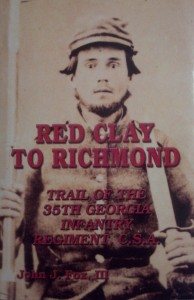
Red Clay to Richmond:Trail of the 35th Georgia Infantry Regiment by John J. Fox III copyright 2004 Angle Valley Press
This sad list included John Rigby. He died of acute bronchitis on May 4, 1865 nearly a month after the surrender at Appomattox. He is buried at Elmira’s Woodlawn National Cemetery in grave #2756.
Nancy Rigby never learned the fate of her husband – whether he was killed on the battlefield or captured. Forever holding out hope that he would come home she “refused to apply for a government veteran’s pension until 1893.” When she died in 1897 her family buried her at Liberty Cemetery in Bremen, Georgia. Next to her grave stood an empty spot for John.
All of the above information came out of Red Clay to Richmond to Richmond: Trail of the 35th Georgia published by Angle Valley Press [2004]. I would like to again thank the Pollard and Mullinax families for giving me so much information on their great-great grandfather, John Rigby, and for allowing me to use his image on the cover of the book.
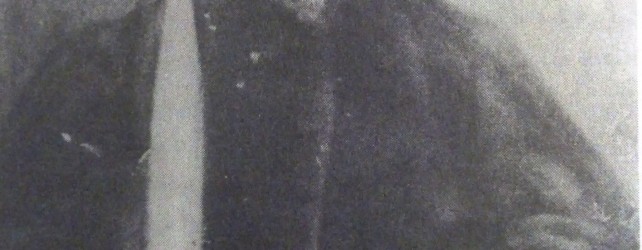
Following the Trail of the 35th Georgia Infantry Regiment on Book’s Tenth Anniversary
By John Fox
May 2014 will ring in the 10th anniversary of the publication of my first book which details the long bloody road of the 35th Georgia Infantry Regiment during the American Civil War. It is hard to believe that Red Clay to Richmond: Trail of the 35th Georgia Infantry Regiment came out ten years ago. Little did I know that a 1987 visit to a frame shop owned by Columbus, Georgia’s Jack and Dian Stroud would launch my Civil War writing path. The Stroud’s framed a Don Troiani print that I had purchased titled “Show Them the Cold Steel Boys!” which portrayed a wild-eyed Brigadier General Lewis Armistead leading his Virginia Brigade over the stonewall and into the muzzles of Union cannon at Gettysburg. Before I left the shop on that fateful day, Dian showed me a framed original letter that a Confederate relative had written. Imagine my surprise when Dian told me that her Aunt Ruby had two shoe boxes of letters written by Private James Marion Garrett to his widowed Mother. I asked, and almost insisted, that these letters needed to be copied and preserved. With my Army background, a history degree from Washington & Lee University and a love for all things Civil War I convinced myself that I was the person to do this. I must have convinced Dian who then convinced Aunt Ruby because several weeks later Dian called to say that she had the letters at the shop if I wanted to come see them.

Red Clay to Richmond:Trail of the 35th Georgia Infantry Regiment by John J. Fox III copyright 2004 Angle Valley Press
I raced back to the shop and soon held these letters written by a young eighteen-year-old Private James Garrett to his Mom. They spanned from 1861 until 1864 and highlighted Garrett’s experience through all the major fighting in Virginia, Maryland and Pennsylvania. The letters revealed the daily trials and tribulations of a Confederate foot soldier both in combat and in camp – from the euphoric high of finding extra food to the low of lows as Garrett scribbled about the death of a good friend.
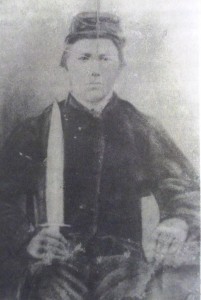
Private James Marion Garrett, Company D, 35th Georgia Infantry Regt.
And then in May 1864, after the fiery fighting at The Wilderness, fate caught up with the young Georgian. Early on May 12, two Confederate brigades led by brigadier generals Edward Thomas and Alfred Scales’ rushed through the dense woods on the east side of the now famous Mule Shoe salient to help Brigadier General James Lane’s Brigade. Union fire into both flanks from Second and Ninth Corps units had pinned down Lane’s North Carolinians.
The sudden arrival of Rebel reinforcements pushed back troops from Union Brigadier General Robert B. Potter’s division assigned to Ambrose Burnsides’ Ninth Corps. Thomas’ excited Georgians, which included the 35th Georgia and Garrett, chased the retreating blue-clad attackers down a steep wooded hill and across a boggy marsh.
The narrative in Red Clay to Richmond noted: “Burnsides’ men slid back behind their entrenchments and watched as the Confederates struggled across the wet march. When the pursuers came within one hundred yards, Federal troops unleashed a torrent of grape, canister and minie balls. This concentrated fire tore huge holes in the Confederate lines. Private James Garrett gasped for breath as he dropped to his knees with a bullet through a lung. Before he completed his fall, another projectile ripped into his hip.”
North Carolinians and Georgians hugged the ground for about two hours as they endured the murderous fire from Burnside’s men. When the Georgians found their right flank turned they hustled “back across the boggy morass and up the steep incline.” The many wounded Southerners remained behind including Garrett.
The 35th Georgia’s sergeant major James P. Johnston noted in a letter to Garrett’s mother that “as soon as night came the ambulance corps found him and carried him to the field hospital.” Garrett hung on in the hospital for three days. A good friend, Sergeant Wilson J. Moore, maintained a bedside vigil and wrote to Mrs. Garrett that her son had left a small pocket book and an ambrotype to be sent home. Moore also noted James’ generosity because he always shared food that the Garrett family had sent from Georgia.
Chaplain John H. Taylor spent much time at the bedside of James Garrett before the young Georgia soldier died. Taylor wrote Mrs. Garrett a letter describing her son’s faith and resolve during his final hours.
When conversing with him a short time before his death about his
prospects of heaven he exclaimed, ‘Oh how glad my mother will be
to hear I died a Christian.’ It is great consolation indeed to
know that he passed away so well preparing with such bright
prospects of heaven. Let that fact fill your heart with gratitude
to God. I know it is hard to part from our dear children, but if
they depart in Jesus we know our loss is their eternal gain. They
can never come to us but we can go to them. May the God of all
love fill your heart with peace and comfort. And remember that
you have a treasure in heaven which should be an additional
motive to make you think more of that blessed place. We wrapped
him in his blanket and buried him as best as we could under the
circumstances. You may rest assured that all that could be done
was done. Hoping that these lines will be of great comfort to
you, I remain your humble servant.
A burial detail placed the body of twenty-one-year-old Private James M. Garrett into the ground near the field hospital on May 15, 1864. Several years later, the numerous bodies buried near this spot were removed to Spotsylvania Confederate Cemetery. However, Mrs. Garrett never learned the exact burial location of her son’s body.
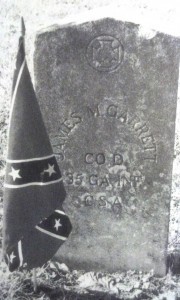
Grave of Pvt. James M. Garrett, 35th Georgia at Spotsylvania [VA] Confederate Cemetery
Then in the mid-1990s I talked with Keith Bohannon who was doing some work for the NPS at Fredericksburg-Spotsylvania Military Park. Keith soon located young James Garrett’s grave and he sent me a photo of the headstone. Jack and Dian Stroud, Aunt Ruby, the extended Garrett Family and I all finally had an answer to a more than 130-year family mystery.
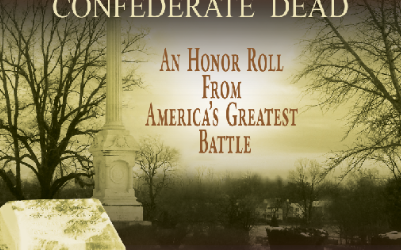
Edit finished on “Gettysburg’s Confederate Dead”
By John Fox
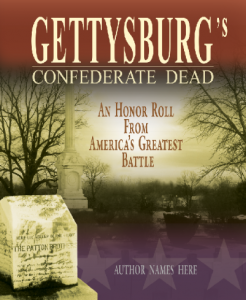 I just finished editing Gettysburg’s Confederate Dead: An Honor Roll from America’s Greatest Battle by Robert K. Krick and Chris L. Ferguson. All I can do is shake my head and say “Wow!” I say this not only because of the incredible research counted by endless painstaking hours but more importantly by the misery and sorrow encapsulated by each soldiers’ name on this roster.
I just finished editing Gettysburg’s Confederate Dead: An Honor Roll from America’s Greatest Battle by Robert K. Krick and Chris L. Ferguson. All I can do is shake my head and say “Wow!” I say this not only because of the incredible research counted by endless painstaking hours but more importantly by the misery and sorrow encapsulated by each soldiers’ name on this roster.
This book includes the most accurate list ever compiled of Gettysburg’s Southern dead. Each soldier is listed by name, rank & company & regiment, date of birth, date of death, brief personal info, and burial spot. There are 5006 names on the list which adds up to 30,036 line entries. This represents a huge amount of work for veteran historians Krick and Ferguson. Those familiar with the Civil War field will certainly recognize Bob K. Krick’s name as he is an expert on Lee’s Army of Northern Virginia and he retired as the National Park Service’s chief historian for Fredericksburg & Spotsylvania National Military Park. He has written numerous excellent books which include Stonewall Jackson at Cedar Mountain [2001] and Conquering the Valley [1996]. Chris Ferguson is widely regarded as an expert on Confederate military records and he has written Hollywood Cemetery: Her Forgotten Soldiers [2001] and Southerners at Rest: Confederate Dead at Hollywood Cemetery [2008].
This newest book, to be released by Angle Valley Press, represents a huge resource for historians, genealogists, family researchers and students of the War. But the one thing that keeps staring back at me off the pages is the huge amount of suffering born by each soldier whose name made the list. That suffering and anguish spread exponentially throughout the South as families learned the fate of their loved ones. Some families never really got closure on what happened to their brother, father or cousin as the roster all too frequently notes “Missing in Action and Presumed Dead – Burial Spot Unknown.”
During the first week of June 1863, Robert E. Lee’s army, numbering nearly 80,000 veterans, began to move toward the Shenandoah Valley to use it as a conduit to invade Maryland and Pennsylvania. While on the march, how many of these men thought that this might be their last campaign? Probably all of them. What would the 3rd Georgia’s Edward Aaron have done if he knew that he would be the first on this alphabetical list of death from Gettysburg? Or the three Almands – John, Reuben and William – all from Cobb’s Georgia Legion and all possibly brothers. What became of the body of the 34th North Carolina’s major George McIntosh Clark? He was killed in action and buried in front of Gettysburg College but the body has never been found. Is it still there or has it been pushed around by a bulldozer blade and perhaps re-landscaped into an athletic field?
Then I drop three more lines down from Major Clark’s listing and I come to twenty-one-year-old Jonathan Clark. This young man served in the 42nd Mississippi and he fell on July 1. His father, forty-eight-year-old Captain Thomas Goode Clark, also fell nearby. Their bodies never made it into any marked grave. I cannot imagine the grief that Mrs. Clark must have felt when this news traveled back to Mississippi.
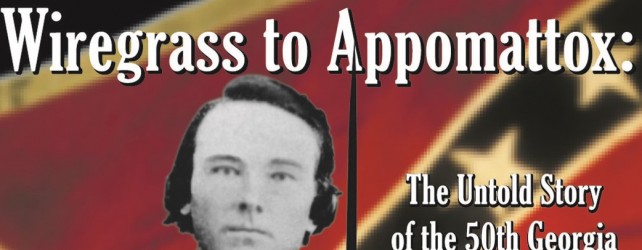
Civil War Battlefield Preservation at South Mountain
Battle of Fox’s Gap Preservation Effort
The Civil War Trust [CWT] has a remarkable opportunity to purchase the 45 acres of Wise’s Field at Fox’s Gap where a tremendous battle took place on September 14, 1862. The carnage during the fight for control of the gaps on Maryland’s South Mountain was a precursor to the Battle of Sharpsburg [Antietam] three days later. Through Federal matching grants the CWT needs to raise $112,500 by March 31, 2014 to preserve this Hallowed Ground.
The 50th Georgia’s baptism of fire came while fighting in Wise’s Field. There, the regiment suffered “an astonishing 86 percent casualty rate, more than it would experience in any other single battle of the war.” Two generals would be killed in action near this field – Confederate brigadier general Samuel Garland and Union major general Jesse Reno.
Angle Valley Press published Jim Parrish’s critically acclaimed Wiregrass to Appomattox: The Untold Story of the 50th Georgia Infantry Regiment in 2008. To support the CWT effort, Angle Valley Press will donate $5 for every copy of Jim’s book ordered through our website’s book order page. These books will all be signed by the author and come to you with free shipping/handling. All of the below excerpts come from Wiregrass to Appomattox as the Georgians found themselves surrounded on three sides at Wise’s Field.
At about 4 pm, the men in the green 50th and 51st Georgia regiments moved across Wise’s Field to a position along the Old Sharpsburg Road. As they executed the movement “they came under heavy fire from a portion of Brigadier General Orlando B. Wilcox’s division.” Troops in the 79th New York and the 17th Michigan poured a horrendous enfilade fire into the Rebels.
“In the sunken road [Old Sharpsburg Rd.] the dead and wounded piled up as volley after volley of enemy fire continued to rake the huddled Georgians.” The 50th Georgia’s lieutenant Peter McGlashan noted “‘the slaughter was horrible,’” while another officer referred to the spot as “‘a slaughter pen.’” Then the 17th Michigan came out of the woods at charge bayonet and smashed into the 50th Georgia’s exposed left flank and rear. Lieutenant McGlashan described the carnage: “‘When ordered to retreat I could scarce extricate myself from the dead and wounded around me. A man could have walked from the head of our line to the foot on their bodies.’”
“One final tragic insult was heaped upon the many seriously wounded and dead from the 50th Georgia and 51st Georgia regiments as they lay in the Old Sharpsburg Road. Private George Hitchcock of the 21st Massachusetts described the horrible scene: “‘The sunken road is literally packed with dead and dying rebels who had held so stubbornly the pass against our troops who have resistlessly swept up over the hill. Here the horrors of war were revealed as [we] see our heavy ammunition wagons go tearing up, right over the dead and dying, mangling many in their terrible course. The shrieks of the poor fellows were heartrending.’”
Color Sergeant George Fahm from Thomas County, Georgia reflected on his good fortune to escape. He noted that the other eight members of the 50th Georgia color guard were shot down while “‘the flag, flag-staff, clothing, cap and blanket of the color bearer (myself) showed thirty-two bullet holes, and yet most strangely to relate, I did not receive a scratch in that battle.’”
The fighting on South Mountain continued until after dark. “That night, Robert E. Lee reluctantly decided to abandon his position on South Mountain and withdraw his troops before daylight the next morning. He would move west across Antietam Creek to a better defensive position along the heights around Sharpsburg.”
The stage was now set for an even bigger collision on September 17 at a small Maryland town named Sharpsburg. “All of the dead and many of the seriously wounded Confederates from South Mountain had to be left on the battlefield when Lee withdrew back to Sharpsburg. Those wounded who could not escape were captured and taken to Federal hospitals in the area. The hard and rocky soil made the gruesome job of disposing of Confederate dead a difficult one for Union burial details. In one instance, Federals unceremoniously dumped the bodies of fifty-eight Rebels into an unfinished well on Daniel Wise’s property. In 1874, the remains of 2,240 Southern soldiers were relocated to the Confederate Section of Rose Hill Cemetery at Hagerstown, Maryland. A plaque lists the names of those few soldiers who could be identified, but the vast majority are unknown.”
All above quotes from Wiregrass to Appomattox: The Untold Story of the 50th Georgia by James W. Parrish, 2008, Angle Valley Press, www.AngleValleyPress.com
Civil War Trust to Preserve 45 acres at South Mountain
Angle Valley Press is excited to see that Civil War Trust CWT has established a campaign to preserve 45 acres at Fox’s Gap on South Mountain [MD] where significant fighting took place on September 14, 1862. Jim Parrish who authored Wiregrass to Appomattox: The Untold Story of the 50th Georgia Infantry Regiment noted that this battle was the 50th Georgia’s baptism of fire. The precise field where these Georgians found themselves surrounded on three sides by Federal troops is the precise property being preserved through this CWT campaign. For more info see the Civil War Trust website. This acreage is truly Hallowed Ground. We want to support the CWT in this effort so we will donate $5 from every copy of Wiregrass to Appomattox purchased from the Angle Valley Press website or via mail order. Your order will also be inscribed by Jim Parrish. More will follow here outlining the vicious fighting that took place that day at Fox’s Gap.
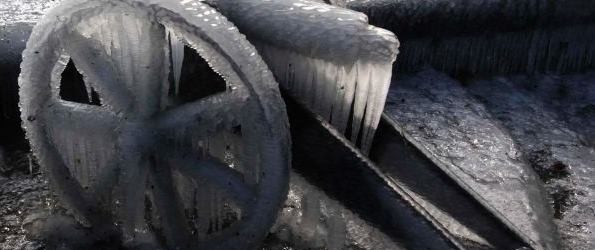
Picket Duty During a Deep Freeze in 1862
Picket Duty During a Deep Freeze
By John Fox
If you want to really know what thoughts, ideas and feelings rambled around in the minds of people from the past then the best place to begin is their letters, diaries and period newspapers. These are called primary sources. The problem though is that too many authors/historians today are too lazy to track down primary sources and they rely on secondary sources which is how a lot of nonsensical “history” (fabrication) gets passed down.
As the bone-chilling cold continues to cover the Shenandoah Valley I thought back to a an account written by Sam Watkins from his famous book “Co. Aytch” which details his life during the War Between the States while he served as a private in the 1st Tennessee Infantry Regiment. The below account comes from pg 62 of the book and Watkins recorded his sentiments during the first week of January 1862 when he went to relieve a picket detail early in the morning prior to sunrise as the temperature hovered near 0 F. The 1st Tennessee was part of Stonewall Jackson’s Romney Campaign and the sad scene took place near Bath, Virginia which is now Berkeley Springs, West Virginia just north of Winchester.
“At a little village called Hampshire Crossing, our regiment was ordered to go to a little stream called St. John’s Run, to relieve the 14th Georgia Regiment and the 3rd Arkansas. I cannot tell the facts as I desire to. In fact my hand trembles so, and my feelings are so overcome, that it is hard for me to write at all. But we went to the place that we were ordered to go to, and when we arrived there we found the guard sure enough. If I remember correctly, there were just eleven of them. Some were sitting down and some were lying down; but each and every one was as cold and as hard frozen as the icicles that hung from their hands and clothing – dead! They had died at their post of duty. Two of them, a little in advance of the others, were standing with their guns in their hands, as cold and as hard frozen as a monument of marble – standing sentinel with loaded guns in their frozen hands! The tale is told. Were they true men?”
[“Co. Aytch”: A Side Show of the Big Show, by Sam R. Watkins, originally published 1952 by McCowat Mercer Press and reprinted 1987 by Broadfoot Publishing Co., p. 62]

